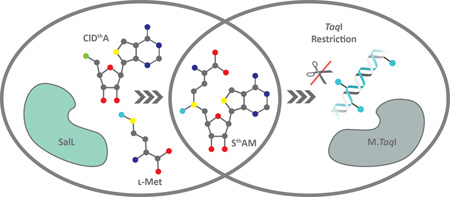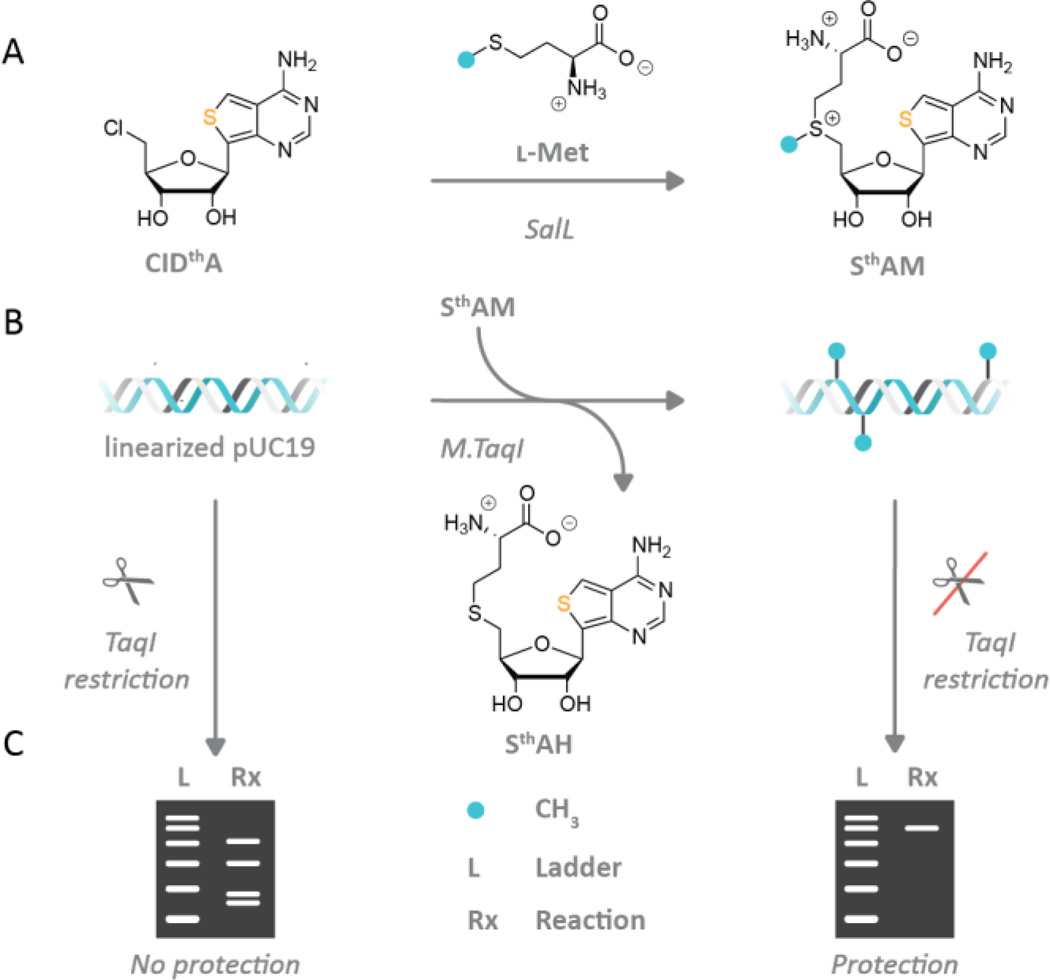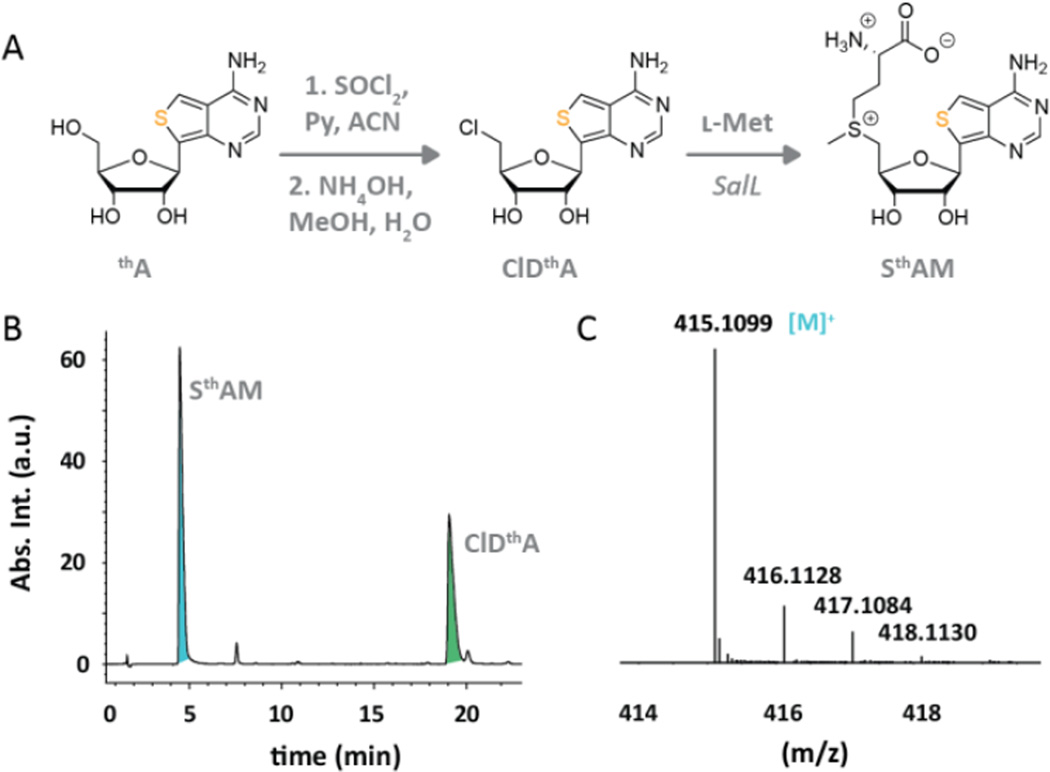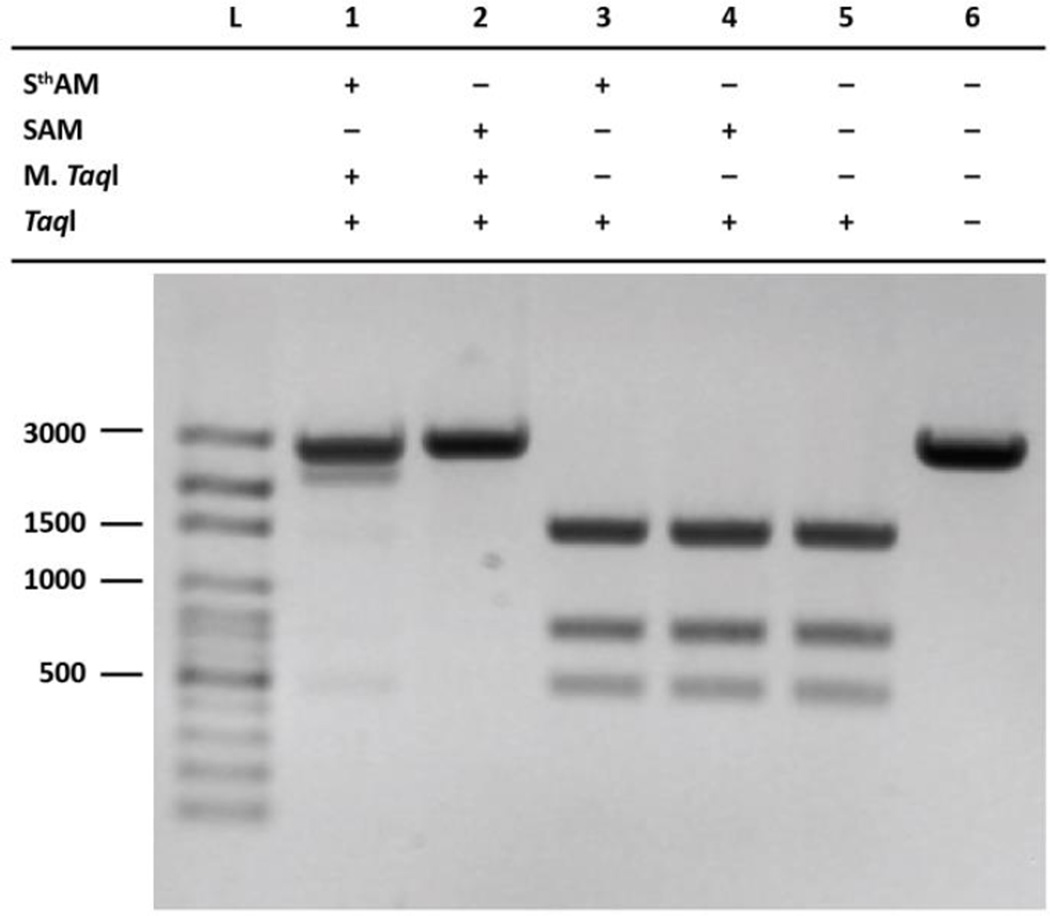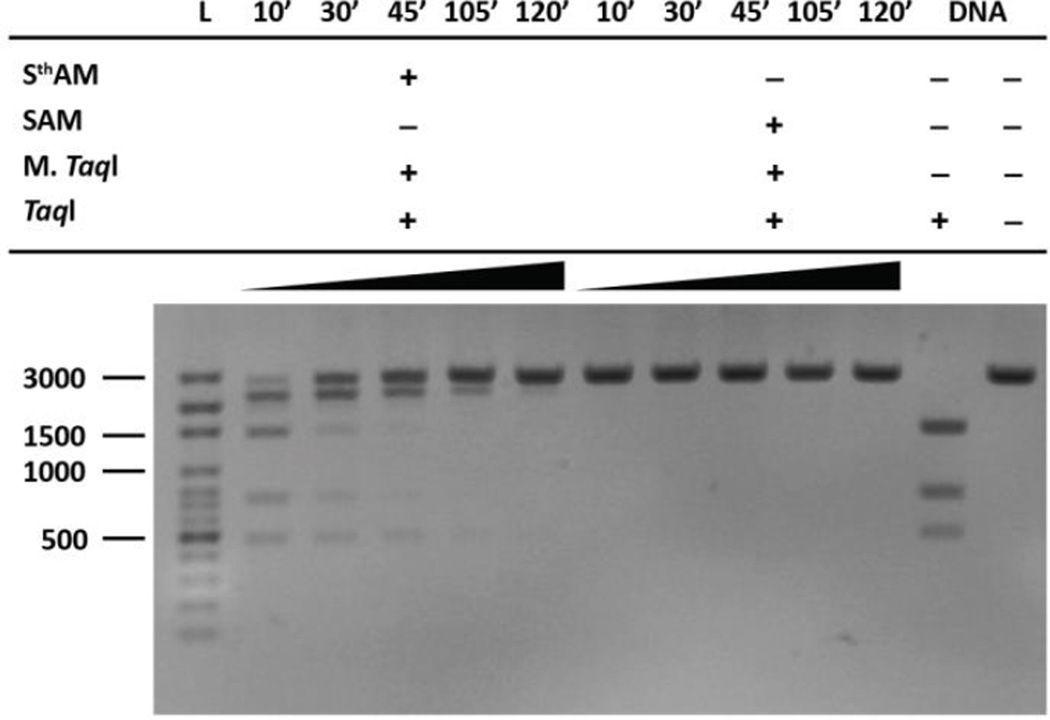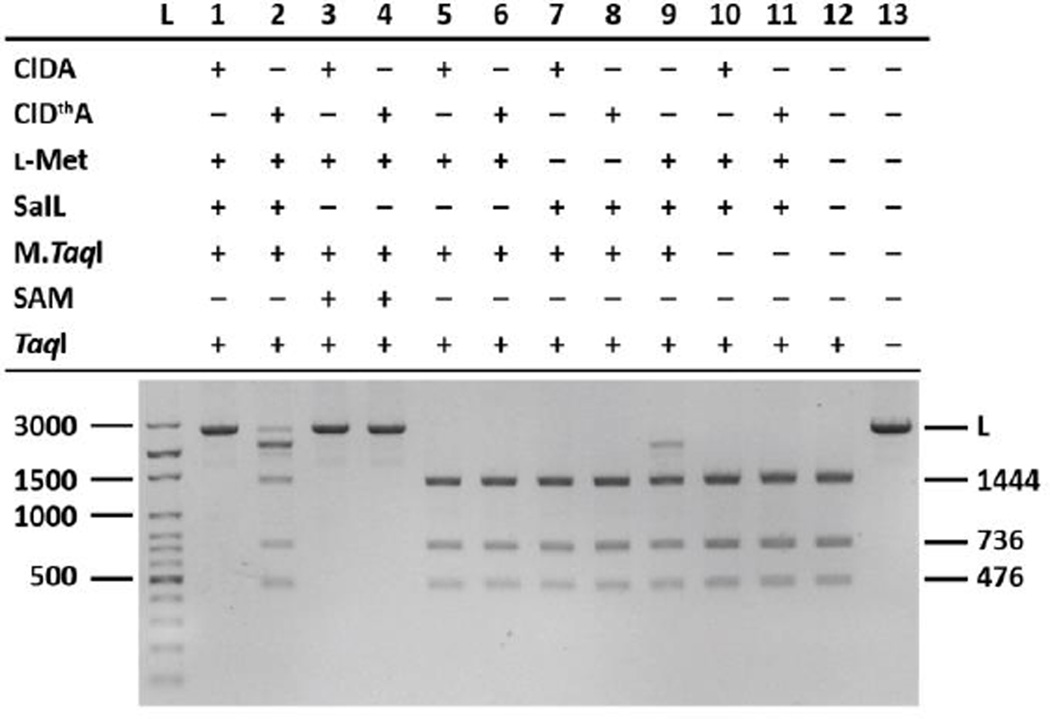Abstract
SalL, an enzyme that catalyzes the synthesis of SAM from l-methionine and 5’-chloro-5’-deoxyoadenosine, is shown to accept 5’-chloro-5’-deoxythienoadenosine as a substrate and facilitate the synthesis of a synthetic SAM analog with an unnatural nucleobase. This synthetic cofactor is demonstrated to replace SAM in DNA methylation reaction with M.TaqI.
Graphical abstract
A synthetic SAM analog with an unnatural isomorphic nucleobase is enzymatically synthesized and shown to serve as a methyl donor
Following ATP, S-adenosyl-l-methionine (SAM, also known as AdoMet) is the most ubiquitous and utilized adenosine-containing cofactor.1 SAM serves as the methyl donor in numerous methyltransferase (MTase)-catalyzed reactions, which are responsible for methylating both large biopolymers (e.g., DNA, RNA, proteins) and low molecular weight metabolites (e.g., catecholamines, polyketides).2, 3 It has also been discovered to bind riboswitches, highlighting its regulatory roles in transcription and translation.4–6 As such, defects in SAM metabolism and its associated reactions are intimately linked to human health.7, 8
Due to its universal role as the source of methyl groups, modified SAM analogs have been gaining utility in a variety of chemical biological applications.9 Modified analogs where the sulfonium center has been replaced by an aziridinyl 10–15 or a (2-haloethyl)amino-group (N-mustard)9, 16–19, have been used to conjugate or crosslink biomolecules involved in SAM-mediated transformations.9 In another class of SAM analogs, the methyl group has been replaced by a larger chemical entity that could directly be transferred to a substrate by methyl transferases, diverse SAM-dependent enzymes.20–23 Such modified SAM analogs can be used to further functionalize biomolecules through bioorthogonal conjugations, such as Click reactions. Clickable groups have been used, for example, to biotinylated biomolecules or to conjugate diverse fluorophores to DNA for super-resolution optical DNA mapping.24, 25
SAM analogs with isomorphic nucleobases have been minimally studied,26 and the tolerance of the enzymes involved in their biosynthesis and methylation reactions has not been broadly assessed. Such analogs can shed light on the fidelity of enzymes involved in metabolic processes and can potentially be used as mechanistic and biophysical probes.27 Furtheremore, due to their distinct heterocylic nucleus, confering unique photophsycial features, they can faciliate the fabrication of biophysical and inhibitor-discovery assays.28 Before advancing such applications, a viable enzymatic approach to such molecules is needed, and their biochemical performance needs to be assessed.
SAM can be enzymatically synthesized by SAM synthetases using l-methionine and ATP.31, 32 This reaction has been utilized to prepare a library of non-native S/Se-containing modified SAM analogs and to alkylate small molecules in situ.33 Alternatively, chemoenzymatic synthesis of several SAM analogs has been demonstrated using SalL, a chlorinase from Salinaspora tropica.34 This halogenase is known to naturally catalyze the breakdown of SAM to l-methionine and 5’-chloro-5’-deoxyadenosine (ClDA), but the reaction can be reversed in vitro, at low chloride and high l-methionine concentrations. Using this enzyme, different SAM analogs were synthesized and in situ utilized to enzymatically alkylate a small molecule, a peptide and DNA.35, 36
To explore whether of not such metabolic partners tolerate SAM analogs with unnatural heterocycles, which are not derived from adenosine, we have investigated the ability of SalL to synthesize SthAM, a SAM analog where adenosine has been replaced by a thieno[3,4-d]pyrimidine-based adenosine surrogate (Fig. 1). This heterocycle is a member of a modified RNA alphabet we previously fabricated as a mechanistic and biophysical tool kit for exploring transformations of nucleosides, nucleotides and oligonucleotides.28, 37–39 Here we demonstrate the successful SalL-mediated synthesis of SthAM from l-methionine and 5’-chloro-5’-deoxythienoadenosine (ClDthA). We then subsequently illustrate the applicability of SthAM as the methyl donor in methyl transferase-mediated DNA methylation. These results illustrate the broad tolerance of enzymes involved in the biosynthesis of SAM and its methyl transfer reactions to alterations of the adenosine moiety.40
Fig. 1.
A. SthAM is enzymatically prepared from ClDthA and l-methionine using SalL. B. Methylation of linearized pUC19 DNA with M.TaqI and SthAM is followed by a strand cleavage step with TaqI (a restriction enzyme). C. Reactions are then analyzed by agarose gel electrophoresis. Methylation (protection) prevents any digestion and shows full length DNA. Unmethylated DNA shows full digestion after the exposure to a restriction enzyme.
The synthesis pathway to SthAM commences with the conversion of the nucleoside thA to its 5’-chloro-5’-deoxy derivative ClDthA (Fig. 2A), following established procedures.29, 30 Incubating this halogenated non-native nucleoside with SalL and a large excess of l-methionine (×75) at 37°C, generates SthAM, the modified analog. The formation of the desired product during the enzymatic reaction was monitored by HPLC and confirmed by HR-MS (Fig. 2. B and C, Fig. S3† and S7†). The production of SthAM could be scaled up and optimized by increasing reaction volumes and using higher concentrations of the enzyme. The best conversion we observed, as reflected by the highest ratio of product (SthAM) to starting material (ClDthA) was 1.38, reflecting consumption of about 60% of the chlorinated nucleoside (Fig. S4†). Control experiments show no formation of SthAM in the absence of the enzyme excluding any direct substitution reaction between l-methionine and ClDthA (Fig. S6†).
Fig. 2.
A. Synthesis of SthAM. ClDthA is synthesized from the modified nucleoside thA using an established chlorination method.29, 30 which is then converted to SthAM using l-methionine and SalL. B. HPLC trace of a typical enzymatic SthAM synthesis reaction, containing 0.2 mM ClDthA, 15 mM l-Met and 9 μM SalL for 2 hours at 37°C. C. HR-MS trace of SthAM, purified using HPLC.
To study its capability as a methylating agent, SthAM was used in a DNA methylation-restriction assay with a common DNA substrate (a pUC19 plasmid linearized by SacI) and an M.TaqI methyl transferase (MTase). This enzyme naturally catalyzes the methylation of the exocyclic amino group of adenine within the 5’-TCGA-3’ sequence in double stranded DNA. The methylation reaction can then be followed by incubation with the Endonuclease TaqI. This enzyme has the same recognition sequence as M.TaqI, but is unable to cleave the methylated DNA sequences. Finally, the reactions are analyzed by agarose gel electrophoresis using ethidium bromide staining (Fig. 1). A control reaction with SAM, the natural cofactor, can be executed in parallel to compare the two methyl donors. As seen in Figure 3, after an hour long reaction, a nearly complete protection was observed with SthAM (Fig. 3, lane 1), compared to a complete reaction with SAM, the native cofactor (lane 2). Control reactions (lanes 3–6) confirm the need for all components for a successful DNA protection.
Fig. 3.
Methylation of linearized pUC19 DNA by M.TaqI MTase. A DNA marker (100–3000 bp) was used as a reference (lane L). Lane 1 and 2 show the result after the reaction using SthAM and SAM respectively. Negative controls in the absence of M.TaqI for the reaction with SthAM (lane 3), SAM (lane 4) or no cofactor (lane 5) are shown. Lane 6 shows a control reaction in absence of any cofactor or enzyme.
To semi-qualitatively compare the reaction rates of M.TaqI with SAM and SthAM, the DNA methylation reaction was followed over a 2 hour time course (Fig. 4). Five time points were taken for each cofactor after 10, 30, 45, 105 and 120 min exposure to the MTase, followed by incubation with TaqI. While the reaction with SAM was virtually quantitative after 10 min (lanes 6–10), the reaction with SthAM was slower but essentially reached completion after 2 h (lanes 1–5).
Fig. 4.
Time course methylation-restriction assay of linearized pUC19 DNA by M.TaqI methyltransferase. A 100bp ladder DNA marker (100–3000 bp) was used as a reference (lane L). During the methylation reaction, five time points were taken for both SthAM (first group of time points) and SAM (second group of time points). After treatment with TaqI, the reactions were analyzed on a 1% agarose gel. The DNA lane shows the control in the absence of M.TaqI and cofactor, in the presence and absence of TaqI.
To test whether SthAM can be formed in situ and used directly in a methylation reaction, SalL and M.TaqI were combined in a one-pot reaction (Fig. 5). This combined synthesis/methylation reaction and the subsequent cleavage were done for both ClDA (lane1) and ClDthA (lane 2). Positive controls in which SAM was added in the absence of SalL (lane 3 and 4) were also performed. Negative controls in which either SalL (lane 5 and 6), l-Met (lane 7 and 8), ClDA/ClDthA (lane 9) or M.TaqI (lane 10 and 11) were omitted and one control with only DNA (lane 12 and 13) were performed under the same conditions. The reaction with ClDA (lane 1) showed full protection. The one where ClDthA was used (lane 2) shows partial protection and the negative controls show no protection as expected, with the exception of lane 9, where one extra band with a higher molecular weight compared to the largest possible fragment is present. This extra band, indicating partial DNA protection, could result from small amounts of in situ generated SAM. The latter is formed from traces on ClDA bound to SalL, which has been reported to co-purify with A and ClDA when expressed in chloride-containing media.30 As exogenous ClDA/ClDthA is absent in Lane 9, traces of SAM facilitate a small, yet observable, protection and therefore leads to a partly “false positive” result. Nevertheless, as the full length DNA is not present in this control lane, but is present in lane 2, the protection seen in the latter must be due to the formation of SthAM.
Fig. 5.
Combination synthesis-methylation-restriction assay using linearized pUC19 DNA, SalL and M.TaqI. Lane L is a 100bp ladder DNA marker (100–3000 bp). Lane 1 and 2 are the combination reactions with respectively ClDA and ClDthA. Lane 3 and 4 are positive controls in the presence of SAM, but absence of SalL. Negative controls with respectively ClDA and ClDthA were performed in the absence of SalL (lane 5 and 6), of l-Met (lane 7 and 8) and of M.TaqI (lane 10 and 11). Controls without ClDthA (lane 9) and only DNA (lane 13) are shown.
Although SthAM appears to be somewhat inferior to SAM in its enzymatic synthesis and methyl transfer reactions, it is rather remarkable that the enzymes involved in its synthesis and utilization show such tolerance for nucleobase modifications. In particular, while the halogenated adenosine has been crystallographically shown to be buried within the SalL active site,34 with the Asn188’s amide side chain forming two H bonds to the Hoogsteen face of adenine, the enzyme tolerates the replacement of the imidazole unit in adenine with a thiophene. In contrast, M.TaqI does not appear to form specific contacts with the adenine’s imidazole moiety,41 which may explain its higher tolerance and ability to effectively utilize SthAM in DNA methylation reactions. (Fig. S8†)
Conclusions
A chemoenzymatic synthesis of SthAM, a new functional SAM analog, has been accomplished by combining l-methionine and ClDthA in a reaction catalyzed by SalL, an enzyme known to perform a similar reaction with ClDA. The new synthetic cofactor could be used for DNA methylation reactions in a methylation-restriction assay using a pUC19 vector and M.TaqI MTase. These results highlight the isomorphicity of thA, a new adenosine isoster, and the tolerance level of enzymes involved in the biosynthesis and utilization of SAM. The availability of functional analogs with altered nucleobases can also facilitate future biophysical analyses and mechanistic studies of biochemical processes involving this abundant cofactor. Our observations suggest that thA, a highly isomorphic adenosine surrogate, may be able to substitute the native nucleoside in other cofactors and second messengers.
Supplementary Material
Acknowledgments
Support to J.H. from the European Research Council under the European Union’s Seventh Framework Program [FP7/2007-2013]/ERC Grant Agreement [291593 FLUOROCODE] and the Flemish government in the form of long-term structural funding ‘Methusalem’ [METH/08/04 CASAS] was gratefully acknowledged. C.V. thanks the KU Leuven for the JuMo scholarship. We thank the US National Institutes of Health for generous support (GM 069773 to Y.T.), and UCSD’s Chemistry & Biochemistry MS Facility.
Footnotes
Electronic Supplementary Information (ESI) available: Synthesis and characterization of new compounds, Expression of SalL enzyme, enzymatic procedures and control experiments. See DOI: 10.1039/x0xx00000x
Notes and references
- 1.Schubert HL, Blumenthal RM, Cheng X. Trends Biochem Sci. 2003;28:329–335. doi: 10.1016/S0968-0004(03)00090-2. [DOI] [PMC free article] [PubMed] [Google Scholar]
- 2.Zhang J, Zheng YG. ACS Chemical Biology. 2016;11:583–597. doi: 10.1021/acschembio.5b00812. [DOI] [PMC free article] [PubMed] [Google Scholar]
- 3.Struck AW, Thompson ML, Wong LS, Micklefield J. Chembiochem. 2012;13:2642–2655. doi: 10.1002/cbic.201200556. [DOI] [PubMed] [Google Scholar]
- 4.Winkler WC, Breaker RR. Annu Rev Microbiol. 2005;59:487–517. doi: 10.1146/annurev.micro.59.030804.121336. [DOI] [PubMed] [Google Scholar]
- 5.McDaniel BA, Grundy FJ, Henkin TM. Mol Microbiol. 2005;57:1008–1021. doi: 10.1111/j.1365-2958.2005.04740.x. [DOI] [PubMed] [Google Scholar]
- 6.Trausch JJ, Xu Z, Edwards AL, Reyes FE, Ross PE, Knight R, Batey RT. Proc Natl Acad Sci U S A. 2014;111:6624–6629. doi: 10.1073/pnas.1312918111. [DOI] [PMC free article] [PubMed] [Google Scholar]
- 7.Anstee QM, Day CP. J Hepatol. 2012;57:1097–1109. doi: 10.1016/j.jhep.2012.04.041. [DOI] [PubMed] [Google Scholar]
- 8.Mischoulon D, Fava M. Am J Clin Nutr. 2002;76:1158S–1161S. doi: 10.1093/ajcn/76/5.1158S. [DOI] [PubMed] [Google Scholar]
- 9.Zhang J, Zheng YG. ACS Chemical Biology. 2015 [Google Scholar]
- 10.Comstock LR, Rajski SR. J Am Chem Soc. 2005;127:14136–14137. doi: 10.1021/ja054128y. [DOI] [PubMed] [Google Scholar]
- 11.Comstock LR, Rajski SR. Nucleic Acids Res. 2005;33:1644–1652. doi: 10.1093/nar/gki306. [DOI] [PMC free article] [PubMed] [Google Scholar]
- 12.Pignot M, Siethoff C, Linscheid M, Weinhold E. Angew Chem Int Ed Engl. 1998;37:2888–2891. doi: 10.1002/(SICI)1521-3773(19981102)37:20<2888::AID-ANIE2888>3.0.CO;2-4. [DOI] [PubMed] [Google Scholar]
- 13.Pljevaljcic G, Pignot M, Weinhold E. Journal of the American Chemical Society. 2003;125:3486–3492. doi: 10.1021/ja021106s. [DOI] [PubMed] [Google Scholar]
- 14.Pljevaljcic G, Schmidt F, Peschlow A, Weinhold E. Methods Mol Biol. 2004;283:145–161. doi: 10.1385/1-59259-813-7:145. [DOI] [PubMed] [Google Scholar]
- 15.Pljevaljcic G, Schmidt F, Weinhold E. Chembiochem. 2004;5:265–269. doi: 10.1002/cbic.200300739. [DOI] [PubMed] [Google Scholar]
- 16.Weller RL, Rajski SR. Org Lett. 2005;7:2141–2144. doi: 10.1021/ol0504749. [DOI] [PubMed] [Google Scholar]
- 17.Weller RL, Rajski SR. Chembiochem. 2006;7:243–245. doi: 10.1002/cbic.200500362. [DOI] [PubMed] [Google Scholar]
- 18.Hymbaugh Bergman SJ, Comstock LR. Bioorganic & Medicinal Chemistry. 2015;23:5050–5055. doi: 10.1016/j.bmc.2015.05.001. [DOI] [PubMed] [Google Scholar]
- 19.Du Y, Hendrick CE, Frye KS, Comstock LR. Chembiochem. 2012;13:2225–2233. doi: 10.1002/cbic.201200438. [DOI] [PubMed] [Google Scholar]
- 20.Dalhoff C, Lukinavicius G, Klimasauskas S, Weinhold E. Nat Protoc. 2006;1:1879–1886. doi: 10.1038/nprot.2006.253. [DOI] [PubMed] [Google Scholar]
- 21.Klimasauskas S, Weinhold E. Trends Biotechnol. 2007;25:99–104. doi: 10.1016/j.tibtech.2007.01.006. [DOI] [PubMed] [Google Scholar]
- 22.Parks LW. J Biol Chem. 1958;232:169–176. [PubMed] [Google Scholar]
- 23.Schlenk F, Dainko JL. Biochim Biophys Acta. 1975;385:312–323. doi: 10.1016/0304-4165(75)90359-1. [DOI] [PubMed] [Google Scholar]
- 24.Vranken C, Deen J, Dirix L, Stakenborg T, Dehaen W, Leen V, Hofkens J, Neely RK. Nucleic Acids Res. 2014;42:e50. doi: 10.1093/nar/gkt1406. [DOI] [PMC free article] [PubMed] [Google Scholar]
- 25.Neely RK, Dedecker P, Hotta J-i, Urbanaviciute G, Klimasauskas S, Hofkens J. Chemical Science. 2010;1:453–460. [Google Scholar]
- 26.Ottink OM, Nelissen FHT, Derks Y, Wijmenga SS, Heus HA. Analytical Biochemistry. 2010;396:280–283. doi: 10.1016/j.ab.2009.09.013. [DOI] [PubMed] [Google Scholar]
- 27.Leonard NJ. CRC Crit Rev Biochem. 1984;15:125–199. doi: 10.3109/10409238409102299. [DOI] [PubMed] [Google Scholar]
- 28.Sinkeldam RW, McCoy LS, Shin D, Tor Y. Angew Chem Int Ed Engl. 2013;52:14026–14030. doi: 10.1002/anie.201307064. [DOI] [PMC free article] [PubMed] [Google Scholar]
- 29.McGee DPC, Martin JC. Canadian Journal of Chemistry. 1986;64:1885–1889. [Google Scholar]
- 30.Micoli A, Turco A, Araujo-Palomo E, Encinas A, Quintana M, Prato M. Chemistry. 2014;20:5397–5402. doi: 10.1002/chem.201304780. [DOI] [PubMed] [Google Scholar]
- 31.Cantoni GL. Journal of the American Chemical Society. 1952;74:2942–2943. [Google Scholar]
- 32.Gross A, Geresh S, Whitesides GM. Appl Biochem Biotechnol. 1983;8:415–422. doi: 10.1007/BF02779914. [DOI] [PubMed] [Google Scholar]
- 33.Singh S, Zhang J, Huber TD, Sunkara M, Hurley K, Goff RD, Wang G, Zhang W, Liu C, Rohr J, Van Lanen SG, Morris AJ, Thorson JS. Angew Chem Int Ed Engl. 2014;53:3965–3969. doi: 10.1002/anie.201308272. [DOI] [PMC free article] [PubMed] [Google Scholar]
- 34.Eustaquio AS, Pojer F, Noel JP, Moore BS. Nat Chem Biol. 2008;4:69–74. doi: 10.1038/nchembio.2007.56. [DOI] [PMC free article] [PubMed] [Google Scholar]
- 35.Lipson JM, Thomsen M, Moore BS, Clausen RP, La Clair JJ, Burkart MD. Chembiochem. 2013;14:950–953. doi: 10.1002/cbic.201300221. [DOI] [PMC free article] [PubMed] [Google Scholar]
- 36.Thomsen M, Vogensen SB, Buchardt J, Burkart MD, Clausen RP. Org Biomol Chem. 2013;11:7606–7610. doi: 10.1039/c3ob41702f. [DOI] [PMC free article] [PubMed] [Google Scholar]
- 37.Shin D, Sinkeldam RW, Tor Y. Journal of the American Chemical Society. 2011;133:14912–14915. doi: 10.1021/ja206095a. [DOI] [PMC free article] [PubMed] [Google Scholar]
- 38.Mizrahi RA, Shin D, Sinkeldam RW, Phelps KJ, Fin A, Tantillo DJ, Tor Y, Beal PA. Angew Chem Int Ed Engl. 2015;54:8713–8716. doi: 10.1002/anie.201502070. [DOI] [PMC free article] [PubMed] [Google Scholar]
- 39.Shin D, Lonn P, Dowdy SF, Tor Y. Chem Commun (Camb) 2015;51:1662–1665. doi: 10.1039/c4cc08809c. [DOI] [PMC free article] [PubMed] [Google Scholar]
- 40.Ottink OM, Nelissen FH, Derks Y, Wijmenga SS, Heus HA. Anal Biochem. 2010;396:280–283. doi: 10.1016/j.ab.2009.09.013. [DOI] [PubMed] [Google Scholar]
- 41.Labahn J, Granzin J, Schluckebier G, Robinson DP, Jack WE, Schildkraut I, Saenger W. Proc Natl Acad Sci U S A. 1994;91:10957–10961. doi: 10.1073/pnas.91.23.10957. [DOI] [PMC free article] [PubMed] [Google Scholar]
Associated Data
This section collects any data citations, data availability statements, or supplementary materials included in this article.



